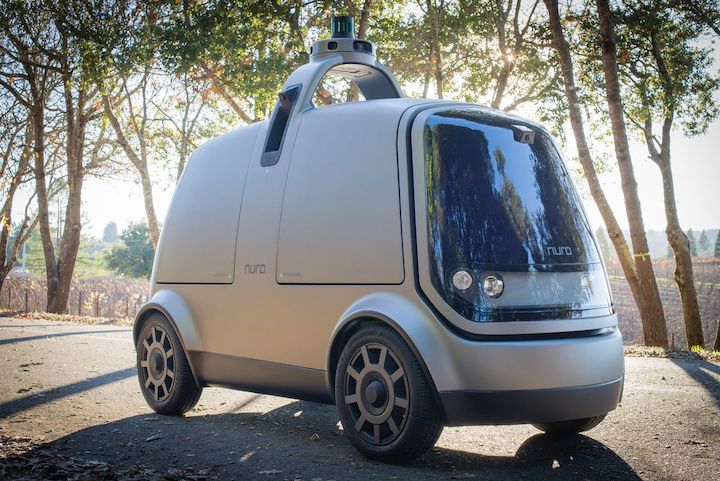The future of transportation is battered and fried, with some gooey cheese stuffed in the middle.
That’s the message in some small autonomous driving developments that have some pretty big consequences. While venture capitalists salivate over sentient transport trucks and robot SUVs that can safely navigate a Boston blizzard, some of the smartest self-driving engineers are making progress flipping chicken sandwiches.

Kiwibot, a five-year-old startup, unveiled a Star Wars-esque droid that looks like a cooler on wheels. The company has been shuttling burritos and other square-foot-size packages around Berkeley, Calif., for years, but its newest bot has a killer upgrade: It can go indoors. Airports, malls, hospitals and offices (read: desk-side lunch), are all on the table now, according to Chief Operations Officer Diego Varela Prada. The goal, ultimately, is to cut delivery costs and times in half for restaurants, retailers and customers.
“Everyone talks about last-mile delivery, and they don’t really mean last mile,” Varela Prada explains. “We really mean it — one mile and less in dense, urban areas.” The new Kiwibot will even trundle into elevators, he says.
The beauty of both business models is that they display humility as much as ambition. The companies’ modest approaches recognize technology is about iteration as much as gobsmacking breakthroughs; and iteration is about experience. With fast-food and sidewalk retail, Nuro, Kiwibot and their rivals are out there getting their repetitions — real-world reps, rather than the simulations self-driving car startups have come to rely on. More important, they are getting paid for them.
“Until now, our partnerships have typically centered around scheduled delivery of goods, such as groceries or prescriptions,” says Cosimo Leipold, Nuro’s head of partnerships. “Pizza is much more on-demand, and that presents additional operational learnings for us as we continue to scale our fleet.” For starters, speed will be critical, and orders will cluster around dinner-time and big sporting events.
These companies are figuring out how the machines are being received by the public at large, a question largely left out of the self-driving narrative until people started egging Waymo vans in Arizona. Kiwibot had its ah-ha moment three years ago, when a 6-year old walked into its California headquarters with a cardboard concept that had heart-shaped eyes. “She basically said, ‘I saw your robot on the street, and it’s really ugly,” Varela recalls. The new droid unveiled this week borrows heavily from the kid’s vision; it can display 22 different “faces” on its forward screen, including hearts and a wink.
“It generates engagement and trust, and trust is one of the top blockers when it comes to adoption,” Varela said. “We see the transactional, functional aspect of a robot going hand in hand with the emotional aspect of it.”
Big rigs made news this week as well, but their progress is slow and less cheerful. Main Street investors got their first crack at TuSimple Holdings, a robot-truck startup, with its initial public offering on Thursday. Shares of the company, backed by $2 million in annual revenue and $178 million in losses last year, lost ground out of the gate. And Aurora Innovations, which bought Uber’s self-driving unit early this year, outlined its plans for selling self-driving trucks before it turns to moving passengers around. Nuro has dipped a toe into trucking, too, with its December acquisition of Ike, a startup founded by Google and Uber alumni.
To be fair, calling the Nuro and Kiwibot rigs “self-driving” is still a stretch. Nuro declined to say whether its pods have any human chaperones, as has been the protocol in the past. And Kiwibot droids are monitored remotely in much the same way military pilots fly war-zone drones from suburban U.S. bases. The economics, however, are already starting to pan out.
Nuro reckons almost half of short trips in the U.S. are for groceries or errands. Meanwhile, online food delivery in the U.S. is somewhere around a $30 billion business, about half the size of ride-sharing. It got a major boost during the pandemic, while crowds of people stopped opening their Lyft and Uber apps.
“What we’ve seen over the last few years is that people want everything delivered, faster and more affordable,” Leipold said. “Historically, speed comes with cost, but Nuro is changing that.”
Morgan Stanley figures the addressable market for U.S. restaurant delivery is $350 billion, much of that factoring in all the places that haven’t bothered with house calls. Still, food delivery is an economic minefield. Restaurants generally hate the commission they have to fork over to DoorDash and other third-party platforms. Those same platforms have struggled to post profits and keep their gig workers happy. An army of robots would spruce up the unit economics all around, and they wouldn’t grumble about wages and benefits.
“(These) platforms are likely to continue to match the order with the fastest while safest and most efficient delivery vehicle available,” says Morningstar analyst Ali Mogharabi, “whether it’s one driven by a delivery person or an autonomous one.”
The link between the auto industry and rational thought has always been distant and tenuous at best. (Ask anyone buying a new car which ones they are considering.) And that’s just fine, helpful even. We wouldn’t have transmissions or air bags or Teslas if some starry-eyed engineers didn’t try to do something really hard. But the timeline on autonomous driving has been getting dialed back for years.
At this point, as self-driving slouches toward the future, the greenest shoots of innovation are budding in the shadows — in airport parking lots, assisted-living communities and, pretty soon, malls. Kiwibots are following workers back to the office. Nuro pods are zipping around field hospitals ferrying medicine and fresh linens to Covid patients. Perhaps soon, pepperoni pies as well.









